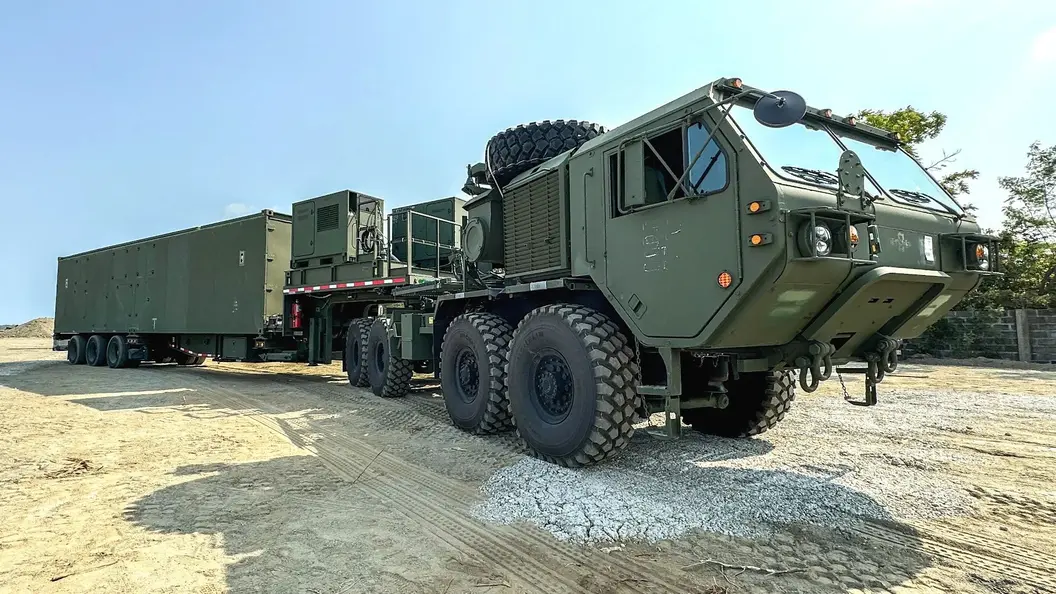US Typhon Missile System In Philippines: A Counter To Chinese Aggression?

Table of Contents
The Strategic Rationale Behind the Deployment
The decision to deploy a hypothetical US Typhon missile system in the Philippines rests on several key strategic pillars.
Addressing Chinese Assertiveness in the South China Sea
China's increasingly assertive behavior in the South China Sea is a primary driver behind this potential deployment. China's actions include:
- Increased naval activity: Routine patrols and military exercises within disputed waters, often disregarding international norms.
- Island fortification: Construction of artificial islands and military bases on disputed features, expanding China's effective control.
- Harassment of fishing vessels: Intimidation tactics against fishing boats from neighboring countries, restricting access to traditional fishing grounds.
- Disregard for international law: Rejection of international court rulings and persistent claims based on historical interpretations that conflict with international maritime law.
A US Typhon system, with its long-range capabilities, could potentially deter such actions by providing a credible threat of retaliation. The system's presence aims to directly counter China's growing military dominance in the region.
Enhancing the Philippines' Defense Capabilities
The Philippines' existing defense capabilities are relatively limited compared to its larger neighbors. A US Typhon system would significantly bolster its defensive posture:
- Improved surveillance: The system’s advanced sensors could enhance the Philippines’ situational awareness, providing early warning of potential threats.
- Rapid response capabilities: The system’s quick reaction time would allow for rapid response to any aggressive actions.
- Increased deterrence: The mere presence of such a sophisticated system could act as a significant deterrent against further Chinese encroachment.
This deployment addresses the imbalance of power and enhances the Philippines' ability to defend its sovereign territory and Exclusive Economic Zone (EEZ).
Strengthening the US-Philippines Alliance
The deployment reinforces the longstanding security alliance between the US and the Philippines. This enhanced partnership includes:
- Enhanced interoperability: Joint military exercises and training enhance the effectiveness of both nations' forces.
- Mutual defense commitments: The deployment underscores the US commitment to the defense of the Philippines, a key ally in the region.
- Increased trust: The shared commitment to security enhances mutual trust and strengthens the bilateral relationship.
This deployment serves as a powerful symbol of the enduring strategic partnership between the two nations in the face of external threats.
The Capabilities and Limitations of the Hypothetical Typhon Missile System
Understanding the capabilities and limitations of a hypothetical Typhon system is crucial in assessing its strategic value.
Range, Accuracy, and Payload
Let's assume, for the sake of this analysis, the Typhon system possesses:
- Extended range: Capable of reaching targets hundreds, even thousands, of kilometers away.
- High accuracy: Utilizing advanced guidance systems for pinpoint accuracy, minimizing collateral damage.
- Varied payload: Equipped with various warheads, allowing for flexible responses depending on the nature of the threat.
These capabilities would enable the system to engage a range of targets, from naval vessels to land-based installations.
Deployment Locations and Strategic Implications
The strategic placement of the Typhon system within the Philippines is paramount. Hypothetical locations, chosen for their proximity to potential conflict zones and logistical considerations, would:
- Maximize coverage: Ensure wide coverage of the disputed areas in the South China Sea.
- Reduce response times: Minimize response times to potential threats.
- Enhance surveillance: Improve overall situational awareness in the region.
However, these deployment sites might also be vulnerable to attack, making robust security measures essential.
Potential for Escalation
The deployment of a sophisticated missile system carries inherent risks:
- Risk of miscalculation: The possibility of misinterpreting actions and escalating the situation inadvertently.
- Unintended consequences: The potential for unforeseen repercussions and unintended escalation of hostilities.
- Importance of de-escalation strategies: The need for clear communication and de-escalation mechanisms to manage the risks effectively.
Diplomatic efforts, alongside military deterrence, are crucial to mitigating these risks and preventing an uncontrolled escalation of tensions.
Broader Regional Implications and International Responses
The deployment of a hypothetical US Typhon system has far-reaching regional and international consequences.
Impact on Regional Security Dynamics
The deployment could trigger several reactions:
- Reactions from ASEAN members: Varying responses from other Association of Southeast Asian Nations (ASEAN) members, reflecting diverse national interests and geopolitical alignments.
- Potential for arms races: A potential trigger for further military buildup in the region, leading to an escalating arms race.
- Impact on regional stability: A potential destabilizing factor, especially if it exacerbates existing tensions.
The deployment significantly alters the regional security landscape, influencing the balance of power in the South China Sea.
International Law and the South China Sea Dispute
The legal implications of the deployment are complex:
- UNCLOS (United Nations Convention on the Law of the Sea): The system's deployment must comply with international maritime law as enshrined in UNCLOS.
- Territorial claims: Its potential impact on overlapping territorial claims and the ongoing disputes in the South China Sea.
- International arbitration: The possibility of legal challenges and their implications for regional stability.
Navigating these legal complexities is essential to ensure the deployment adheres to international norms and avoids further complicating the disputes.
Conclusion
The hypothetical deployment of a US Typhon missile system in the Philippines presents a complex strategic calculation. It offers enhanced deterrence against Chinese aggression, strengthens the US-Philippines alliance, and bolsters the Philippines' defense capabilities. However, it also carries the risk of escalation, potential for miscalculation, and raises significant legal and geopolitical questions. The system’s effectiveness hinges on its capabilities, strategic placement, and the overall diplomatic context. Further comprehensive analysis is critical to fully understanding its long-term impact on regional stability.
Call to Action: The strategic implications of a potential US Typhon Missile System, or any advanced missile system deployment in the region, demand continued scrutiny. Deepen your understanding of this complex issue by researching the intricacies of regional security, the South China Sea disputes, and the evolving military capabilities affecting the balance of power. Only through informed discussion can we navigate the challenges and opportunities presented by such deployments and work towards lasting peace and stability.

Featured Posts
-
 Wayne Gretzkys Loyalty Questioned Amidst Trumps Tariffs And Statehood Comments
May 20, 2025
Wayne Gretzkys Loyalty Questioned Amidst Trumps Tariffs And Statehood Comments
May 20, 2025 -
 Leclercs Ferrari Future Statement Ahead Of Imola
May 20, 2025
Leclercs Ferrari Future Statement Ahead Of Imola
May 20, 2025 -
 584 Million Ipo Dubai Holding Expands Reit Offering
May 20, 2025
584 Million Ipo Dubai Holding Expands Reit Offering
May 20, 2025 -
 Bribery Conviction Former Navy Admiral Robert P Burke
May 20, 2025
Bribery Conviction Former Navy Admiral Robert P Burke
May 20, 2025 -
 Taiwans Energy Transition Lng As A Key Replacement Fuel
May 20, 2025
Taiwans Energy Transition Lng As A Key Replacement Fuel
May 20, 2025
Latest Posts
-
 Is Big Bear Ai A Smart Investment Now
May 20, 2025
Is Big Bear Ai A Smart Investment Now
May 20, 2025 -
 Reddits Top 12 Ai Stock Picks For 2024
May 20, 2025
Reddits Top 12 Ai Stock Picks For 2024
May 20, 2025 -
 Big Bear Ai Stock Buy Or Sell
May 20, 2025
Big Bear Ai Stock Buy Or Sell
May 20, 2025 -
 Urgent Weather Warning Prepare For Strong Winds And Severe Storms
May 20, 2025
Urgent Weather Warning Prepare For Strong Winds And Severe Storms
May 20, 2025 -
 12 Best Ai Stocks Redditors Recommend
May 20, 2025
12 Best Ai Stocks Redditors Recommend
May 20, 2025
